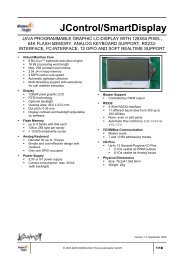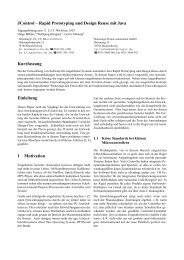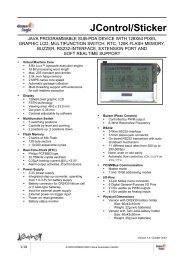JControl/PLUI - DOMOLOGIC Home Automation GmbH
JControl/PLUI - DOMOLOGIC Home Automation GmbH
JControl/PLUI - DOMOLOGIC Home Automation GmbH
You also want an ePaper? Increase the reach of your titles
YUMPU automatically turns print PDFs into web optimized ePapers that Google loves.
abstraction, the external class<br />
jcontrol.io.Backlight is provided, enabling<br />
JOYSTICK SWITCH<br />
The joystick switch enables compound actions by<br />
a single knob. It features five degrees of freedom,<br />
controlled by lever and push operations.<br />
The built-in class jcontrol.io.Keyboard<br />
provides methods to read the switch on character<br />
basis, including raw access, buffered access,<br />
automatic repetition and acoustic feedback.<br />
Fig. 8 gives an overview of the moving directions<br />
of the joystick switch. The letters ‘S’, ‘U’, ‘L’, ‘D’<br />
and ‘R’ are returned by the method read() of the<br />
class jcontrol.io.Keyboard when the switch<br />
REAL TIME CLOCK (RTC)<br />
The real time clock (RTC) of the <strong>JControl</strong>/<strong>PLUI</strong> is<br />
realized by a separate component, connected<br />
internally by the I²C bus to the JCVM8. During<br />
power-off state, the RTC is supplied by a backup<br />
gold cap, keeping the time information up-to-date.<br />
The RTC provides year, month, day, weekday,<br />
hours, minutes and seconds. Besides the current<br />
time, an alarm time is supported by hardware. The<br />
alarm flag may be polled by software.<br />
The built-in class jcontrol.system.RTC<br />
implements methods for reading and writing the<br />
current time and alarm time. A time information is<br />
BUZZER<br />
A piezo buzzer (mounted inside of the device) is<br />
used to generate acoustic signals. The system<br />
uses the buzzer for acoustic feedback of switch<br />
events and for signalling system exceptions. Both<br />
features may be enabled or disabled by the<br />
system properties buzzer.systembeep and<br />
buzzer.keyboardbeep. Additionally, an<br />
application software may control the buzzer using<br />
the external class jcontrol.io.Buzzer,<br />
implementing the interface<br />
jcontrol.io.SoundDevice for hardware<br />
abstraction. This class provides methods to<br />
activate the buzzer using a specified frequency<br />
(250...32767Hz) for a specified duration (in ms).<br />
RS232 COMMUNICATION<br />
The <strong>JControl</strong>/<strong>PLUI</strong> provides one asynchronous<br />
serial communication interface, connected by a<br />
multiplexer switch to two different communication<br />
channels. The first communication channel<br />
<strong>JControl</strong>/<strong>PLUI</strong><br />
to set the backlight in 256 steps from 0 (off) to 255<br />
(max brightness).<br />
is moved to one of these positions. The letters are<br />
defined by the default keyboard map, that may be<br />
changed by an application program for software<br />
compatibility reasons.<br />
S<br />
R<br />
Fig. 8: Moving Directions of the Multifunction Switch<br />
represented by an instance of the built-in class<br />
jcontrol.system.Time, combining the fields<br />
year, month, day, weekday, hours, minutes and<br />
seconds.<br />
The RTC is based on the Philips PCF8563<br />
integrated circuit, clocked by a separate 32.768<br />
kHz quartz crystal. It operates on a supply voltage<br />
down to 1.0 V and consumes approx. 250µA<br />
@VDD=3.0V (Tamb=25°C). The RTC allocates the<br />
I²C-bus slave addresses A3h (for reading) and<br />
A2h (for writing). It may be accessed directly<br />
using the built-in class jcontrol.comm.I2C.<br />
The system property buzzer.enable is provided<br />
to enable or disable the buzzer when it is used by<br />
an application.<br />
Furthermore, the external class<br />
jcontrol.toolkit. iMelody is provided,<br />
playing complete melodies given by the iMelody-<br />
Format (IMY, published by the Infrared Data<br />
Association, IrDA).<br />
The buzzer used inside the <strong>JControl</strong>/<strong>PLUI</strong> is<br />
controlled by the reserved PWM channel #3 and<br />
has a specified frequency range from 250Hz to<br />
20kHz.<br />
(named EXTERNAL) is used to communicate with<br />
a PC, the other (named INTERNAL) is used to<br />
communicate with the integrated Power-Line-<br />
BCU. The switch is controlled by the reserved<br />
© 2003 <strong>DOMOLOGIC</strong> <strong>Home</strong> <strong>Automation</strong> <strong>GmbH</strong> 6/19<br />
L<br />
U<br />
D






